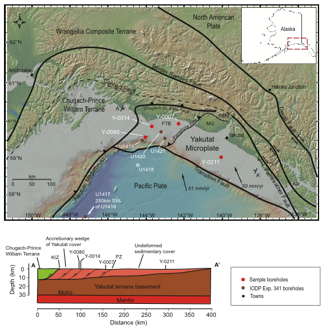Reports: ND854917-ND8: Triggering a Tectonic-Climate Feedback: The Sedimentary Record of Tectonic-Surface Processes Interactions in the St. Elias Range, Alaska
Eva Enkelmann, University of Cincinnati
This project started in August 2015 with a visit to the Alaska Geologic Materials Center in Anchorage to collect borehole samples from the Gulf of Alaska that form the basis for our research project. This one-week visit to Alaska was the start for graduate student Nathaniel Bootes for his Master's thesis research project. During this trip Nate also got to know collaborator and co-advisor Dr. Lease from the USGS in Anchorage, who helped preparing the samples at the storage facility and shipping them to the University of Cincinnati in Ohio.
Over the past year, which was the second year of this research grant and Nate's thesisproject, we finished all the laboratory work and data acquisition. Specifically the detrital zircon double-dating using fission track (FT) and U-Pb analyses were completed in fall 2016 and Nate presented his results and first interpretations at the AGU Annual Fall meeting in December 2016. The majority of laboratory work that was conducted over the past 12 month was devoted to dating detrital apatite grains using FT analysis. Undergraduate student Victoria Thomas started already in spring 2016 with helping to prepare samples for dating, which she continued through the end of 2016. In the meanwhile, Victoria successfully graduated and a new undergraduate student (Anna Schartman) was recruited in fall 2016. Anna is an exceptional undergraduate student that I trained to conduct U-Th/He and FT analysis in the thermochronology lab at Cincinnati. Anna conducted the apatite FT analysis of 20 borehole samples and additional bedrock U-Th/He analysis from samples I collected in the Yakutat Bay region. Those on-land samples were collected during a field trip I was invited to join in 2016. The results of this extra project will be complimentary to the interpretation of our borehole results and the understanding of the exhumation history on land and how this is recorded in the offshore record. Anna is currently conducting thermal history modeling and preparing a manuscript on the bedrock data, which she will present at the GSA Annual Meeting in Seattle (October 2017).
Nate has spent most of the past year with data analysis, reading literature and preparing a first thesis draft, which he submitted to me in September 2017. The focus of his project is on the young (<8 Ma) deposits (14 samples) that can be linked to the development of the St. Elias Mountains. These data will be compared and discussed in the context of the large published dataset of detrital zircon FT data from modern glacial sediment of catchments covering the entire St. Elias Mountains. Additionally, these new data will be put into the context of the recently published detrital zircon FT and U-Pb data from IODP expedition 341 borehole samples (Dunn et al., 2017, JGR-ES). Our new samples are highly complimentary to the IODP study because two of the industry boreholes are at similar locations (Figure), but reach farther back in time (~5 Ma), while the scientific drilling covered only the past <0.8 Ma of sedimentation. This will allow recognizing shifts in the on-land exhumation rates and sediment source regions since the beginning of the Pliocene. The two other boreholes of our study are located at locations farther southeast along the strike of the St. Elias Mountains, allowing us to evaluate spatial variations in sediment routing from source-to-sink. Nate presented his data at the AGU Fall meeting in 2016, and I anticipate that he will finish his thesis in the coming 6 months.
Additionally we analyzed eight samples from older strata with deposition ages ranging from 40 and 18 Ma (Figure). These data will provide insight on the northward translation of the Yakutat plate along the North American margin. Additionally, the detrital apatite FT data of these samples provide information about the thermal history of the strata. Preliminary data analysis has been conducted and suggests partial resetting for some of the samples.
This research project is a new direction for me because I am using the tools of low-temperature thermochronology on sedimentary deposits to study exhumation pattern of the past and link the sediment source to its offshore sink. All my previous research has focused on land, investigating the spatial and temporal pattern of evolving convergent plate margins by analyzing bedrock or modern glacial deposits. I am very pleased with the acquisition of data and I remain hopeful that Nate will continue working on the manuscript. Over the last year he had several phases where he struggled to continue the work. I am not satisfied with the preparation of manuscripts, which is mainly due to the slow progress on Nate's thesis and also my recent move to start a new faculty position. However, I am planning and looking forward to the preparation of manuscripts later this year, when I will prepare presentations for the GSA and AGU Annual Meetings this year.
Figure: Top: Topographic map of southeast Alaska and cross section, depicting the main tectonic units and the borehole location in the Gulf of Alaska. Bottom: Stratigraphy of the four boreholes investigated displaying the distribution of the sample with respect to stratigraphy.













